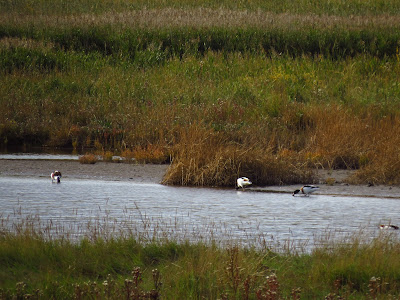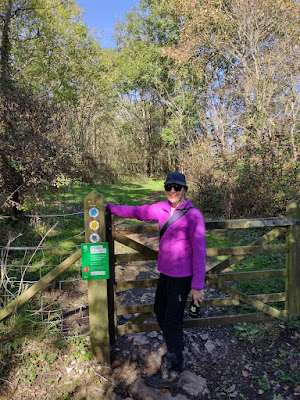After a long absence from regularly updating the blog, what topic is suitable for the Prodigals return? I think maybe a summary of a walk and a visit to the Art in Nature Museum this weekend. A gentle return then.
Saturday October 8th: Walk Cross to Compton Bishop and back
What a superb Autumnal day this was. Virtually no wind, not a cloud in the sky and the October sun in this part of Somerset still packed a punch. Perfect walking weather. I'm still post Covid, therefore in terms of my fitness levels this gentle 3-4 mile saunter was a most suitable length.
Cross, the village, nestles at the base of the Mendip Hills and always seems to be sunny. A former coaching hamlet bisected by ancient roads to Bristol and Wells, hence presumably the name. There is mixed information over the origins of name, either the village was at the crossroads, or the village cross was a meeting place. Doing a little further research failed to establish any other historical evidence for its name. The village was however for the last 20 years of his life home to Frankie Howerd, and his house Wavering Down is now a tourist attraction - in fact today as we passed we watched a man cutting the grass. A highlight of the walk.

Julie had completed this walk the day before with her friend and enjoying it so much suggested it for today. Soon after leaving the village centre we entered a field running along the banks of the Old River Axe. Technically a drain rather than a small river this didn't matter, it was teeming with wildlife. I'm not great at identifying fish, certainly there were trout we could see, but possibly bream and tench in there too. They were everywhere. And hundreds of pond skaters and whirligig beetles. I can't ever recall seeing so many in one place. This seems a healthy habitat, so pencilled in as a place to definitely return to and do some proper natural history exploring.

Continuing along the Old Axe the countryside here is what I'd term gentle. Or even flat! There were a lot of corvids about in the trees, mainly rooks, carrion crow and jackdaw, noisily accompanying our stroll. A green woodpecker undulated off towards a tree yaffling away. Wrens, starlings, meadow pipits and possibly others. Walking without binoculars for exercise is a different experience to ambling along with binoculars, I was in the dog-house a few times for stopping too.
After crossing a stile the river took on a different feel, firstly a bend but then it seemed to develop a different character, the trout here were large, 30-40 cm, but very little in the way of small fish. Magpies followed us on our route squawking away, and we began to slowly walk up hill, away from the river, which eventually outpours into the Bristol Channel a few miles to the west.
Up hill along a farm track brought us to the base of the Mendips and a footpath up to Crook Peak, the highest part of this end of the hills. We were not going that far today.
Instead we were just walking the foothills part so to speak, through woodland, which on a day like today was a magical place to be in with the sun dazzling through the branches, interspersed with shade and coolness. A few speckled wood butterfly and a single small tortoiseshell were the only insects here. It is late in the season after all.
As we climbed, as one would expect, the views opened up from our vantage point hidden within shaded trees to the sun-drenched slopes of the Mendips. I've always loved this landscape on the southern slopes, and, considering we were only a couple of miles only from the M5, Weston Super Mare 8 miles distant, even Bristol less than 20 miles away, this corner of Somerset seems remote, timeless and silent. Well that is apart from the pheasant shooting happening over the valley somewhere.
Compton Bishop across the valley with the church nestled under the slopes.
Eventually we made it to the village of Compton Bishop, after a little detour and chat with a lady walking her dog, who got us back on the right track - and who suggested a longer route for another day. A sleepy backwater of a hamlet really.
Beginning our route back to Cross I spied this abundant ivy over a wall, thick with insects taking advantage of this late season nectar. Ivy in flower is such an important foodstuff for all manner of insects, and when in seed, birds and mammals. This area had not been flailed obviously, sadly further down the lane it had been shorn to within in inch of its life, here no insects could be seen. There is a moral to the story there somewhere.
Okay I know it's childish, but it made me giggle.
Finally we made it back to Cross walking along Webbington Lane rather then as planned along a footpath past an orchard. That route then is for next time, as I really want to return here and do some proper walking cum wildlife sleuthing. Note to self, bring binoculars and a good camera, there's so much to see just beyond arm distance. Walking with a smartphone does allow for lightness of foot but smartphone cameras, while good, are not nearly as good as a SLR for some images.
We got back to Cross and after a chat with a lady pruning a tree, Julie walked on another mile or so to the village of Axbridge where we planned to met up for a lunch. I had had enough, still not 100%, so I drove the car over there but before then noticed this at the outskirts of the village which I'd seen at the beginning of the walk but not really noticed. 'Maggie's Corner'. I like the sentiment of 'to find a spot of green' very much.
Sunday October 9th : Art in Nature Museum, Gloucestershire
I'd not met up with my friend Rob for months and months, so today on his well received suggestion we met at the Art in Nature museum just north of Gloucester. Today was the last day of a Robert Gillmor (6 July 1936 – 8 May 2022) exhibition highlighting his artwork from teenage years to very recent. Gillmor was best known for his covers of the New Naturalist series from the 1980's. His lino-cut work is fantastic and at the exhibition there were 5 lino pads he'd cut to produce an oystercatcher image which was shown alongside. Such bewildering complexity given he had to work in negative relief for each pass of the print, each pass being a different colour. If you don't know his work, there's a nice summary here on the Society of Wildlife Artists website, a Society he co-founded. https://swla.co.uk/members/robert-gillmor

It's a fascinating place to visit anyway as their permanent exhibitions are bolstered by special exhibitions such as the one we went to see today, and artwork and sculptures in the grounds. Plus a rather good café.
Walking around the grounds I noticed these desiccated teasels. I've grown teasel in the garden, and seen it many times out in the wider countryside, but never noticed the leaves when crisp, form a heart. This was replicated in over half the teasels we could see. Interesting and I'll look out for this (is it just a local phenomenon) when out and about this winter.
Finally, this hairy beast caught both Rob and my eye. Rob has an app on his phone which confirmed it as a tiger moth, further confirmed by a couple of better entomologists than me as the caterpillar of the ruby tiger moth Phragmatobia fuliginosa . A perfect end to a perfect weekend.









































